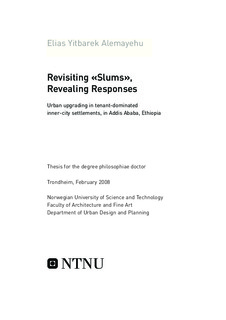| dc.contributor.author | Alemayehu, Elias Yitbarek | nb_NO |
| dc.date.accessioned | 2014-12-19T11:21:27Z | |
| dc.date.available | 2014-12-19T11:21:27Z | |
| dc.date.created | 2008-04-16 | nb_NO |
| dc.date.issued | 2008 | nb_NO |
| dc.identifier | 124119 | nb_NO |
| dc.identifier.isbn | 978-82-471-7121-9 | nb_NO |
| dc.identifier.uri | http://hdl.handle.net/11250/231000 | |
| dc.description.abstract | About eighty percent of Addis Ababa’s settlements are considered “slum”. The study examines the phenomenon of urban upgrading in tenant-dominated non-planned inner-city settlements of the city. It focuses on tenants’ responses and spatial transformations. The phenomenon is investigated through the analysis of case studies located in three localities. The data are primarily collected through qualitative techniques supplemented by a quantitative technique. The investigation is carried out from the perspective in which upgrading is viewed as a process embedded in a dynamic context, rather than a decontextualised static project. Based on the case studies analytical generalizations are made. The study found neither the theories that assert the non-responsiveness of tenants nor the ones that emphasize the sole role of tenure security explain the reality and the needs of tenant-dominated settlements. The relationship among improved property rights, legal frameworks and grassroots organizations are rather found to be central in both stimulating tenants’ responses and curbing uncontrolled spatial transformations. The advantages of social network, connected to indigenous voluntary associations, are also found to be very instrumental in motivating and mobilising tenants. The study also found exclusion-right, in addition to the often emphasized use- and transaction rights of housing, as an important element, not only in unleashing the resources of low-income dwellers, but also in engaging them in upgrading processes. Equally important finding is the way the housing rights/values are manipulated to both avoid gentrification and sustain upgrading processes. Upgrading paradoxes, related to both uncontrolled spatial transformations and the need of the individual and the collective, are revealed and their possible remedy is indicated. The substantive findings are abstracted into generative themes, namely, triggers of change, trigger-based grassroots organizations and actors’ relationships. A trigger-based upgrading process is suggested and recommendations are put forward that lead to a differentiated and flexible policy. | nb_NO |
| dc.language | eng | nb_NO |
| dc.publisher | Fakultet for arkitektur og billedkunst | nb_NO |
| dc.relation.ispartofseries | Doktoravhandlinger ved NTNU, 1503-8181; 2008:59 | nb_NO |
| dc.title | Revisiting "Slums", Revealing Responses: Urban upgrading in tenant-dominated inner-city settlements, in Addis Ababa, Ethiopia | nb_NO |
| dc.type | Doctoral thesis | nb_NO |
| dc.contributor.department | Norges teknisk-naturvitenskapelige universitet, Fakultet for arkitektur og billedkunst, Institutt for byforming og planlegging | nb_NO |
